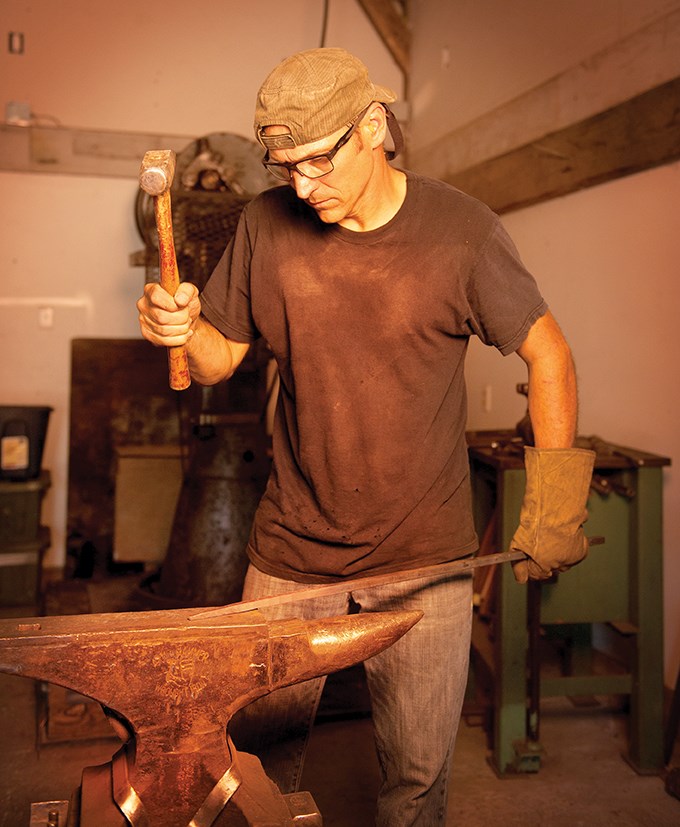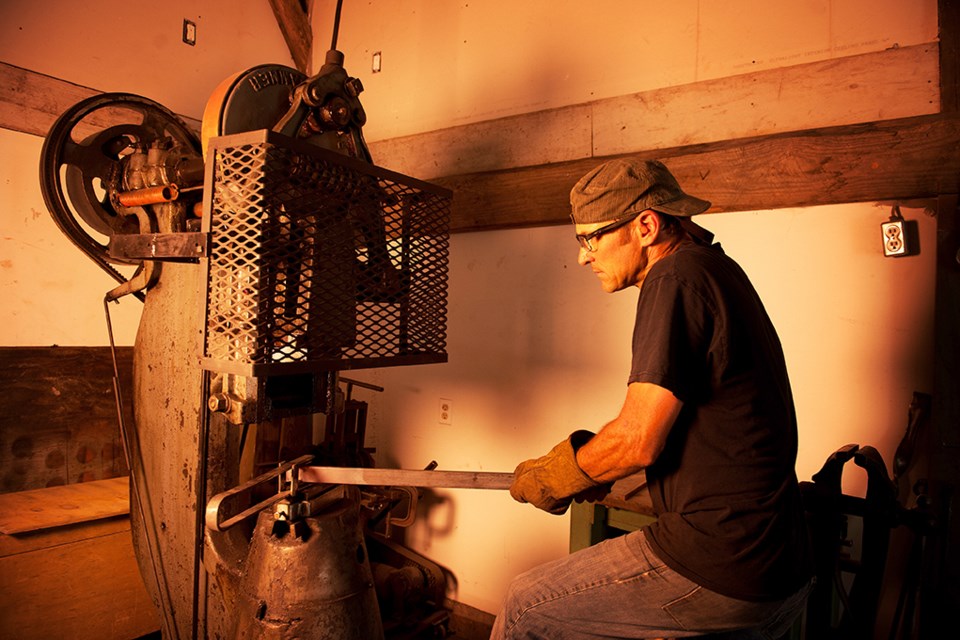Anyone who runs up and down the staircase in the Squamish home, grabbing the ornate metal railing to steady themselves as they go, likely never thinks about the craftsmanship that went into the railing’s creation: the hours of thought, design and hard labour of heating and then bending the steel into swirls or perfect angles.
The staircase, like many of his other creations, came to life in Eric Gindlesperger’s modern blacksmith shop, EG Ironworks, in downtown Squamish, which also houses the traditional tools of the trade: a forge, anvil and hammer.
“We call ourselves artist-blacksmiths because a true blacksmith is the guy who was fixing a wagon wheel or forge-welding and forming equipment back in the day,” Gindlesperger said, as he took a seat on a stool next to a partially completed iron gate destined for a Squamish home.
“Now all that is done by machines… What we are doing is ornamental iron work and my focus is on ornamental iron work for the home and business.”
Gindlesperger, Squamish’s only professional artistic blacksmith, makes home accessories, railing and fireplace sets, screens and security doors.
“Things with an artistic functionality,” he explained.
Traditional blacksmithing has a long history in Canada. The Hudson Bay Company brought the first professional blacksmiths to Canada in the 1670s, according to The Canadian Encyclopedia. The craftsmen were needed to make and repair items that the company didn’t want to ship back to England. The trade blossomed over time.
“The various craftsmen produced work of high aesthetic and technical quality,” said Jean-Claude Dupont in the online encyclopedia.
In the 19th century blacksmiths were particularly important in Western towns along railway lines, such as in Squamish, according to Squamish historian Eric Andersen.
“Being a logging and railway – including rail car manufacturing and locomotive repair – town, and relatively isolated for a long time, blacksmith shops were a critical part of the community infrastructure, keeping things going and inventing solutions,” said Andersen, adding one of the most well-known local blacksmith shops was on Cleveland Avenue for many years.
In his work, Gindlesperger said he tries to incorporate old joinery techniques into a modern design.
“Typically I will build with the forage and the anvil and the power hammer, all traditional tools,” he said.
“I will do a lot of ornamental parts – say the railing for example, and then it gets clamped on to this table and I use my five-year-old welder. I am not doing everything traditionalist.”
Gindlesperger learned his craft from his father, Larry, who was a blacksmith for 40 years in Ohio.
The senior Gindlesperger told The Squamish Chief his son came and watched him work from a young age.
“It was very fun to teach him,” he said from his Ohio home. “I’m very proud of him.”
Ginglesperger said he has adapted the skills and ideas he was exposed to over the years into his own style.
“I am not trying to be the 1800s blacksmith,” he said.
“But by the same token, I draw a lot of the steel, and taper and punch and drift... all the very basic fundamental blacksmithing techniques, I do very regularly and exactly the same way essentially that they were done for hundreds of years. The difference is now I have a nice band saw and I cut with a plasma cutter, so I can cheat a little bit to make it more cost efficient and time efficient.”
The newer techniques open up different avenues for design, Gindlesperger said.
“There’s some really cutting edge blacksmiths doing some really cutting edge things around the world,” he said.
Both Gindlesperger and his father said patience is the most important characteristic for a blacksmith to have.
“What is interesting is, I don’t really have much patience unless I am working with blacksmithing,” the younger Gindlesperger said with a laugh.
“For some reason I have chosen about the slowest profession you could do.”
His least favourite part of the job is the grinding after welding, he said.
“It is using hand-held grinders and just a dirty, loud job that is pretty monotonous,” he said.
Gindlesperger said there is always a demand for handmade, high-quality items like what he creates, but then there are people who want to go online and buy something for cheap.
“I am not going to try to compete with the $30 Etsy hairpin [furniture] legs,” he said.
“Most of the stuff I build will outlast me for sure, for generations.”
His main clientele are fellow Squamish residents, he said, and he also sells to people in Whistler and West Vancouver.
“That is why [Squamish] is a great place to have a shop,” he said
“I do all I need to do with the client and getting the measurements at their home and then I build everything here and deliver it and install it,” he said.
The steel he uses comes from a local company.
“I try to keep everything as close to the corridor as I can,” he said.
Squamish is a perfect fit for Gindlesperger, who moved to the district six years ago. The outdoors, skiing and mountain bike riding inspire his work.
“I am usually solving a problem on a bicycle,” he said. “Go hit the trails for an hour and a half, come back and get back to it.”
Gindlesperger said the learning never really stops in blacksmithing.
“I know that I will still be learning until the end,” he said.
“It is one of those things, there’s always something new to learn: a different technique or a new tool, or a new way to approach it.”
Gindlesperger says he most enjoys the process of working with steel.
“It is pretty interesting to have basically a dead cold material like steel and give it some life and make it look like something rich and interesting.”
Ultimately, Gindlesperger said he would like to expand his shop and offer blacksmithing classes.
“Part of all of our obligation is to keep it going,” he said.




